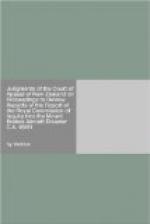Manual, and that this committee was appointed accordingly.
If it had been before the Inquiry it would have supported
the view that Mr Davis had decided the chairman should
not be associated with the flight operations side of
Air New Zealand and for that reason he appointed Mr
Watson who had charge of certain related companies.
There is also an affidavit sworn by Captain Priest
who was appointed by the Airline Pilots Association
to sit as its representative on the committee.
Taken at its face value it is to the effect that he
took part in the committee’s work from the meeting
on 3rd December. In the affidavit he has explained:
“My position on that Committee was an ALPA watchdog—there
were two other independent members”; that as
the inquiry progressed “it became apparent that
the committee was amassing a large amount of papers”;
and that Mr Watson then announced that he had been
directed by the chief executive to get all the information
onto one file and any surplus disposed of to avoid
information getting into the wrong hands. The
affidavit indicates that it was then agreed by the
committee itself that this should be done on the basis
that the master file was to be available to the committee
members at any time and it appears that Captain Priest
joined in that decision. It is not for us to
decide what would have been the effect or significance
of all this material if it had been placed before the
Royal Commission but since the conspiracy to deceive
theory that is developed in the Royal Commission Report
apparently stems from the instruction given by Mr
Davis clearly the officers so gravely affected were
entitled to be warned in advance and so be given the
opportunity to have such information fairly and properly
considered.
Search at Mt. Erebus
The issue of documentary evidence is given extended
attention in a section of the Report headed, “Post-accident
conduct of Air New Zealand” which is exclusively
concerned with suggestions of possible items that
might have been withheld from the Inquiry. The
discussion is introduced at paragraph 342 by a statement
that “This instruction by the chief executive
for the collection of all Antarctica documents had
some unfortunate repercussions”. The observation
is then developed by reference in particular to the
work of Captain Gemmell, the technical flight manager
for Air New Zealand, while assisting Mr Chippindale
at the crash site.
Captain Gemmell had received instructions in the early
hours of the morning of 29th November 1979 to travel
to McMurdo in order to assist Mr Chippindale’s
investigation into the cause of the accident at the
scene. However, by reason of weather conditions
it was not possible for him to be taken by helicopter
to the ice slope until 3 p.m. on 2nd December.
Then, clad in protective clothing and roped to mountaineers,
he assisted in a search for the in-flight recording
equipment (consisting of the cockpit voice recorder
and the “black box”) and the recovery of
any other equipment or documents which might indicate
how the accident had happened.




